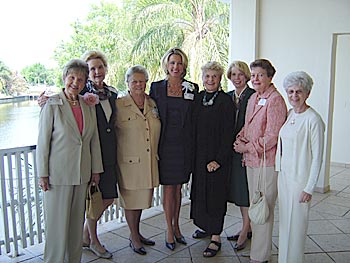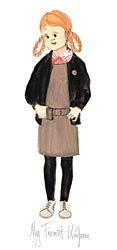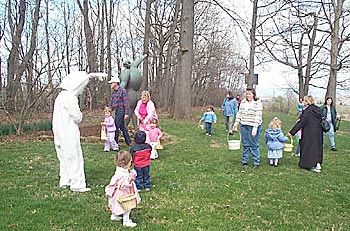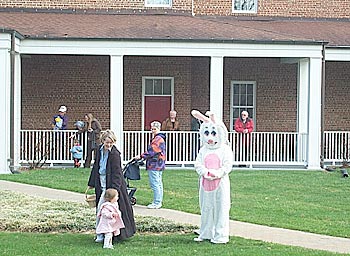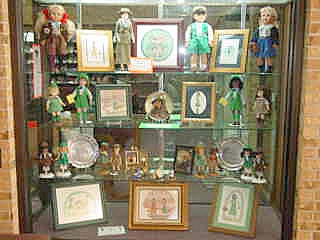Send this e-mail letter to a friend:
Hello My Friends,
Thank you, those of you who wrote to tell me that it is OK when I ramble on and write more than usual. This week I am going to keep my letter short because I need to spend more time in my studio, now that my sister and brother-in-law have left.
Mary (Honey) and Bill are a joy to have come and stay. Sweethearts since their teenage days, they are as much in love in their seventies as they were back then. I was touched to see what good care they take of each other with helping hands when going down steps. Hey! I must watch what I am saying! I will have you thinking they are unsure on their feet and then I will be in trouble like the old days, when as a younger sister, I was not that sharp about when it was time to "get lost."
I have painted many pictures of sisters with Honey in mind as I try to capture the special relationship that exists between loving sisters. Our bonds are the source of our confidence in each other, a confidence that allows us to laugh one moment, cry the next and then impart well thought advice. On those days when it seems that everything I do is off kilter and everyone is looking at me as if I am crazy, a quick call to Honey alters the mood and I regain my positive thoughts.
Pat, with Deborah Norville on her right, at the Suncoast Girl Scout Council luncheon for Women of Distinction.On Tuesday Honey came with me to the Suncoast Girl Scouts Council luncheon for Women of Distinction. Deborah Norville, children's author, Emmy Award winner and anchor of Inside Edition was the keynote speaker. A highly accomplished public speaker, Deborah talked of how her scout training had taught her to always strive to achieve the best. She related the inner strength that scouting gave her to her success in overcoming the challenges of her career.
Like my sister paintings, my scouting paintings are symbols of my appreciation. In the classroom at school, I lacked confidence and remained silent to avoid being ridiculed for mistakes made through my not understanding. This defensive behavior is typical of those of us who have to learn differently because of our dyslexia. In scouting, my natural capabilities came to the fore and I came out of my shell and participated uninhibited by doubts. I am sure you can understand why it is I am so appreciative of the Scouting movement. I am illustrating two brownie prints we are about to publish and a couple of weeks ago I showed you my "Our Leader", an image of a Girl Scout leader.
I have been fortunate to have the company of Marlyn DeWaard following the departure of Honey and Bill. Marlyn is known to many of you for her long association with the World of Moss through her editorship of The Society's newsletter, The Sentinel. Marlyn, whose home is in Michigan, became a Florida snow bird this winter and has been staying in a condo in Clearwater. We teamed up on a couple of occasions and will do so again this week. With Malcolm in Panama supervising our education projects and the rebuilding of our terrace which had been eaten away by termites, I appreciate her company more than ever. For this Easter week, I will have Ginny, Corrado, Pico and Chiara with me. They are driving down from Virginia.
Painting to commemorate the Old Threshers Reunion in Mount Pleasant, Iowa.Now to the studio. This week I completed a painting of steam operated machinery to commemorate the Old Threshers Reunion in Mount Pleasant, Iowa. This is a narrative painting in which I have a number of subjects to include in order to tell the whole story. The challenge is to gather the parts into a cohesive single image. As is often the case in such a painting, I make more than one start as I explore the different possibilities. Sometimes I get a blockage, like a writer's blockage, and I need to put the painting aside and make myself take up some other work. Then when I least expect it, maybe in the middle of the night, I will see clearly how to move on. Such was the case with this painting.
I wish you all Easter Joy. On Saturday the Museum and the Foundation teamed up yet again and organized a children's Easter egg hunt. Cori Lemons, one of the Museum docents was the Easter Bunny and gave and received a lifetime's worth of hugs as seventy children, thirty more than had registered, took part in the hunt. The event was a huge success and so Corrado Gabellieri (Museum Director) and Dell Philpot (Foundation Administrator) have decided to make the Easter Egg hunt an annual event and I am looking forward to when I can be present to take part.
Seventy children enjoyed the Easter Egg hunt at the Museum.That's it for me this week but I am having two "add ons" included with this letter. Carolyn Welch, the owner of The Art Loft Gallery, in Collinsville, Illinois has written a superb piece describing the customs of an Amish funeral. She researched the subject after seeing the image of Mourning Ride which will soon be issued as a print. I thank Carolyn for taking this initiative. I know that many of you will appreciate this opportunity to read about how the Amish handle death and its closure.
The second article is a report that I asked Tricia Miles, my personal assistant, to prepare on a exhibit in Sherman, Texas. I was delighted to learn of my images being incorporated into this public exhibit.
Again have a happy and safe Easter Weekend.
Love,
Pat
The Customs of an Amish Funeral:
Known worldwide as the “People’s Artist”, P. Buckley Moss has taken on the formidable task of creating an image that deals with life’s final chapter - death.
Pat has captured the solemn moment of laying a loved one to rest with dignity and reverence in her newest limited edition print Mourning Reflections. Not only has Moss portrayed her view and understanding of Amish funeral traditions, she has also managed to create a work that makes remembering the life of a loved one the central focus and theme of the image.
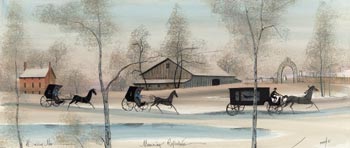
Pat's painting Mourning Reflections.The Amish have always been revered as a people who live a simple life filled with devotion and faithfulness. In true Amish tradition, Pat depicts the ritual of the funeral procession: a) horses trotting - not walking - to their destination; b) the line of carriages, having been numbered by the hostlers, the younger churchmen and boys whose sole responsibility is the organization of the funeral procession, the numbering of the carriages, and the hitching and unhitching of the horses both at the house where a service has already been conducted, and at the graveyard where the service will be continued; and c) the simple graveyard entrance where the service itself will be concluded. Through the funeral ritual and with the anticipation of the ensuing service and the anxiety that often accompanies the occasion, Pat takes us on another journey - one that does not necessarily take away the sadness of having lost someone we cared about and loved, but rather a journey that gives us a certain peace and acceptance. A journey that allows us and even encourages us to reflect upon the life of the dearly departed and to keep alive a spirit and memory that will offer comfort in grieving times.
This journey that Moss takes us on is known by artistic scholars as “iconography”. It is the “message” which will help us understand the meanings of certain symbols that the artist has used to create the image. Iconography requires “education” in the subject matter and the realm of art interpretation. It is that which allows the viewer to experience the artistic intention and identify with the “story” being told. Most of the symbols used in this image are obvious to the viewer (a tree is a tree, the house is a house, etc.); however, it is Moss’ combination that makes Mourning Reflections meaningful.
The artist deliberately moves us through the scene using specific lines and color. Our first stop on this journey is actually on a subliminal level. The viewer’s eye is taken in an upward direction created by the vertical lines given to the trees, buildings, and archway at the entrance to the graveyard, almost lending itself to a feeling of nervous tension. But Moss changes that direction and mood by grounding the image in tranquil shades of blue and earth tones and by using horizontal brush strokes - bringing the eye downward in a sweeping motion, now giving the viewer a feeling of peace. This calmness created by the artist is further enhanced by the quietness of the scene - no hustle and bustle - merely a simple view of the countryside with the only sounds being that of the horses as they trot past on the way to their destination, the graveyard.
The snow in itself in this image is important for several reasons: (1) it, too, muffles noises and creates an audible hush; (2) it hides the ugliness of winter; and (3) it creates the aura of purity - winter in all its glory is nature’s promise that hope arrives in spring. Moss is asking the viewer to stop and reflect - not on the harshness of the situation, but on the inner qualities of life. She is offering us a moment of prayer and solitude, a moment of hope and renewal; an acknowledgment that peace and comfort are within reach.
The trees having been placed into the foreground of the image, just in front of a pond, appear not as translucent shadows but rather stand at attention - straight, tall, and solid - watching, waiting, acting as witnesses to the solemn occasion, almost saluting the memory of the life that passes and which will soon be laid to rest. Their gray color with streaks of black add to their overall strength and their ability to sustain the viewer in this time of sorrow.
Looking toward the pond one can barely see the reflection of the carriages and horses as they move along toward their destination - reflected images so deep in tone that they are almost darker than the carriages and horses themselves. The viewer must note that the human forms are not mirrored in the pond. In art history, it is believed that the reflection of the soul is more important than that of the physical being. The soul is only seen by God.
The movement of the funeral procession on this journey goes along the roadway and welcomes us to stop and contemplate what there is to see. The house allows our minds to wander and gives us a glimpse into the lifetime that passes before us. The structure built with brick leads us to believe that we are putting to rest someone who was a strong and committed leader in the community and provided a stable and secure home for the family; someone who could be relied upon and trusted. The orangish-brown tones of the house reflect the colors of the earth, indicating the person was no stranger to hard work - labor by the sweat of the brow as seen throughout passages in the Bible.
The barn, much larger in size than the house, invites us to make yet another stop and also serves to remind us of the hard work of everyday life that this person was accustomed to. The position of the barn in the center of the picture seems to make the structure a permanent part of the overall environment; and the absence of the roof line causes the building to blend with the landscape so much so that it actually becomes a part of the natural scene providing us, once again, a place of refuge in a cold world.
The entrance to the cemetery is rather nondescript, a simple iron arch painted white and weathered with time. But Pat has again given us, the viewer, something to relate to... the simple curve of the arch with the ground providing a horizontal base, Romanesque in style, mimics the curve of a cathedral and the warm glow given off by the arched, stained glass windows one would expect to find there. Partially round, we are reminded of a segmented circle, which has no beginning / no end, a symbol of eternity, a place through which we all must pass. The love that is felt for this person is not “dead”; it is ongoing and will thrive as those left behind continue to reflect upon the person’s life.
As previously alluded to, color plays an important role in Moss’ artwork because it allows her to share her emotion and mood. The various hues of blue in the sky and foreground have given us the feeling of peace. The white that is used in the patches of snow is a symbol of purity and grace, but the shades of off white in the ironwork at the cemetery entrance and on the ground are reminders that life is not easy. The warm red hues of pinks and oranges that are interspersed throughout the image (almost mimicking the colors of a sunset) are life.
Mourning Reflections does not embrace death; but it does lead us on a journey - a journey that gives us a glimpse into Pat’s thoughts - her attempt to communicate that taking time to reflect on the simpler things in life and loved ones offers peace and comfort in the end. The journey of life in Mourning Reflections has come full circle and is now complete.
Pat's Girl Scout Paintings Shared with the People of Sherman, Texas:
Girl Scouting celebrated its 92nd birthday March 12th. Marking the occasion was a window display in the Sherman (Texas) Public Library, which was put together by the Girl Scouts Cross Timbers Council's memorabilia expert Willy Tennant. Ms. Tennant, who is also a Moss collector, included some of Pat's Girl Scouting-related prints in the display as well as her biography. "Pat strongly believes in and supports the Girl Scout movement," said Ms. Tennant.
Window display at the Sherman, Texas, Public Library celebrating the 92nd birthday of the Girl Scouts.
In addition to Pat's art and biography, the display included Ms. Tennant's noteworthy doll collection depicting Girl Scouts of different time periods. Girl Scouts founder Juliette Gordon Low was also honored in the group of
dolls. A collection of the Girl Scouts stamps and first issue envelopes were in the display as well as some of the Girl Scouts advertisements from the past 92 years. Buster Brown Girl Scout shoes were also part of the display.
The Moss
Portfolio
HC 69 Box 17118 Poplar Grove Lane
Mathews, VA 23109
(800) 430-1320
©P. Buckley Moss 2004
